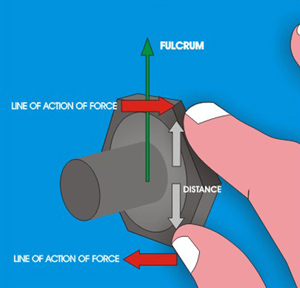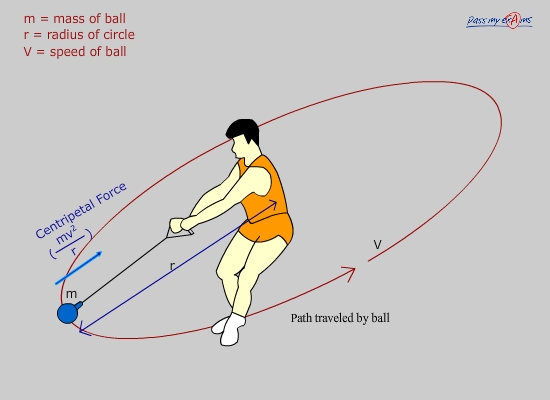Moment
The turning effect of a force is known as
the moment. It is the product of the force multiplied by the
perpendicular distance from the line of action of the force to the
pivot or point where the object will turn.

When undoing a nut fastened to a screw by
hand one realises that the amount of force required is a lot greater
than when undoing the same nut using a spanner. The spanner increases
the distance between the fulcrum and the line of action of the force,
thus for the same force a greater moment is obtained.
 |
 |
SMALL MOMENT
The distance from the fulcrum to the line of action of force is very small |
LARGE MOMENT
The distance from the fulcrum to the line of action of force is large |
Principle of Moments
The principle of moments states that when in equilibrium
the total sum of the anti clockwise moment is equal to the total sum of
the clockwise moment.
When a system is stable or balance it is said to be in
equilibrium as all the forces acting on the system cancel each other
out.
In equilibrium
Total Anticlockwise Moment = Total Clockwise Moment
This principle can be explained by considering two people on a seesaw.

|
Moments Acting On A Seesaw
Person A’s weight is trying to turn the seesaw anticlockwise whilst person B’s weight is trying to turn the seesaw clockwise.
Person A’s Moment = Force x perpendicular distance from fulcrum
1000 x 1 = 1000 Nm
Person B’s Moment = Force x perpendicular distance from fulcrum
500 x 2 = 1000 Nm
Persons A’s moment = Persons B’s Moment
Anticlockwise moment = Clockwise moment
Therefore seesaw is in equilibrium.
Circular Motion & Centripetal Force
From Newton’s first law of motion it is
known that an object will remain stationary, or keep moving at constant
velocity in a straight line unless acted upon by an unbalanced force.
When an object moves in a circular path its direction is changing all
the time therefore according to Newton’s first law there must be an
unbalanced force acting upon it all the time.
When an object moves in a circle although
its speed is constant the direction is continuously changing. Therefore
its velocity is continuously changing as velocity is speed in a
particular direction. The changing velocity in time means the object is
accelerating all the time.
The resultant force which causes this acceleration is the centripetal force.
The centripetal force always acts toward the centre of the circle.The centripetal force is determined from the following equation: 
If a ball is tied to the end of a strong
string and swung in a circle, the ball accelerates towards the centre
of the circle. The centripetal force which causes the inwards
acceleration is from the tension in the string caused by the person’s
hand pulling the string. If the string breaks there is no longer a
resultant force acting on the ball, so it will continue its motion in a
straight line at constant speed.

|



No comments:
Post a Comment